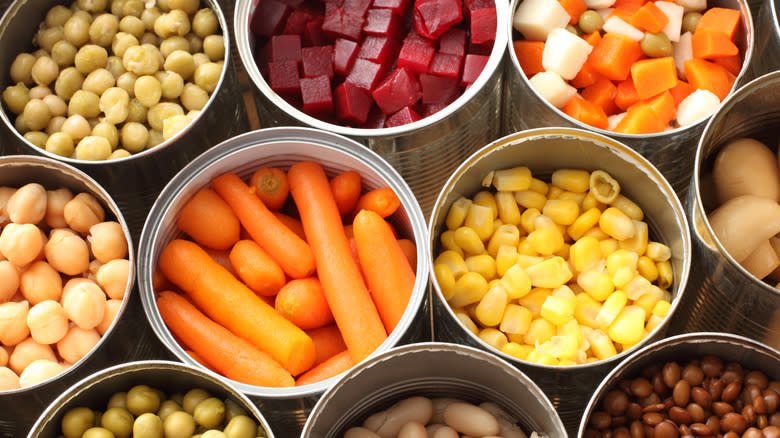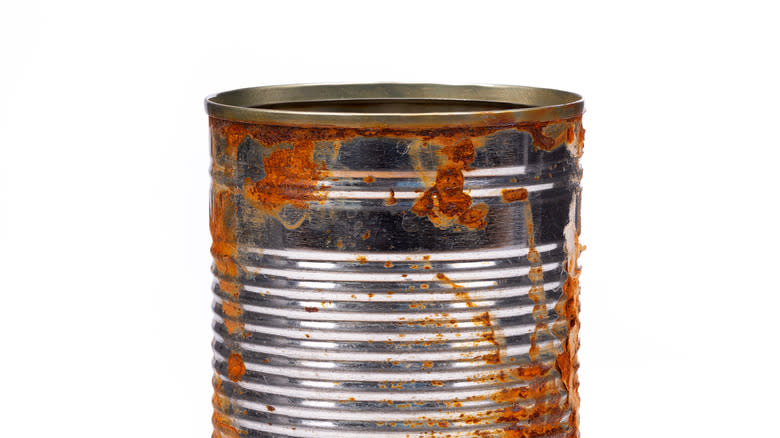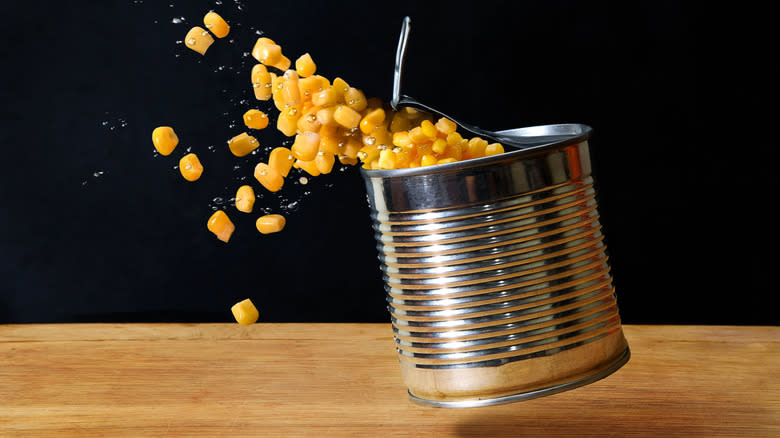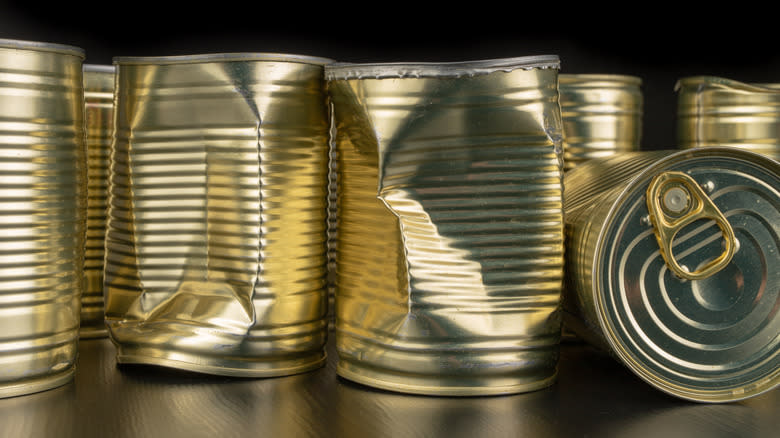How To Tell If Your Canned Food Has Gone Bad

Ah, canned food -- a favorite of doomsday preppers and anyone looking for food that is compact and convenient to store pretty much indefinitely. While there may be a date printed on your cans, this is actually not an expiration date, but rather a "best by" or a "sell by" date. Store-bought canned foods are designed to last pretty much forever, but things can still go wrong. But, if you don't have an expiration date to go by, how can you tell if your canned food has gone bad?
In most cases, your nose will tell you if something is off, but a bad smell is not the only indicator of spoiled canned goods. In this article, we will go into detail about how you can assess the quality of your store-bought canned food and whether or not it is still edible.
Before we get started, we should mention that there is one thing you should never, ever do when checking to see if your canned food has gone bad: Taste it. According to the USDA, spoiled canned food has been linked to botulism, a rare but ultimately devastating form of food poisoning that can potentially lead to paralysis and/or death.
Read more: 13 Canned Foods You Should Avoid At The Grocery Store
The Can Isn't Properly Sealed

If you have ever canned your own food in glass jars, you will know how important it is that canned food has a good seal. As important as a tight seal is in home canning, it is even more important for store-bought canned goods, as these are designed to last much longer.
When a food is placed into the metal can for commercial use, it is considered sterile. A vacuum seal is used to keep bacteria from entering the can once it is closed, which keeps the food inside safe. If no bacteria comes into contact with the food, there is a much lower risk that it could go bad, although it may still become slightly less tasty over the course of a few years or decades.
If you have a can with a flat or pull-tab lid that is not completely attached or has a hole or gap in it, you can assume that the food inside has been compromised. Unless you are the one who accidentally opened the can in the last few minutes (in which case you should eat the contents as soon as possible), you have no way of knowing how long the food inside has been exposed to bacteria, which means that it is best to just throw it out.
The Lid Is Bulging

Have you ever seen a funny-looking aluminum can with a bulging top? While this might be a comical sight, it is actually a sign of a serious problem. A puffy top on a can means that there are gasses building up inside. These gases are created by bacteria and yeast that cause food to spoil. As they build up, the pressure inside the can increases, but there is nowhere for it to go. This then causes the top of the can to bulge as the gases expand and try to escape. Most likely, if you were to open this can, there would be quite the fireworks show (think rotten green beans splattered all over you and the wall). So, in short, don't do it!
If you have a bulging can, it is best to dispose of it as quickly as possible by placing it (still closed) inside a heavy-duty garbage bag. Close the bag without adding other trash, and place it carefully with the rest of the non-recyclable trash to be picked up on your regular trash collection day. You can also take it directly to the landfill.
You See Rust Or Corrosion

Almost anything that is made out of metal has the potential to rust, including cans of food. You will recognize this rust as a reddish, flaky patch on the can. While you may be tempted to think that rust on the exterior is purely aesthetic and has no effect on the contents of the can, you would be wrong. When rust forms as a reaction to moisture and/or salt, it eats away at the metal, forming small holes you may not see. Those holes allow bacteria to enter, which cause the food inside to spoil. For this reason, it is best to store your canned goods in a cool, dry place away from any moisture. If you see rust on your cans, it's best to throw them out.
But wait, that's not all! In addition to the rust that may appear on the outside, rust and corrosion may appear on the inside as well. This can happen if the contents of the can are very acidic, as in the case of tomatoes or pineapple. The acid in the food reacts with the metal and causes its lining to become damaged, making the food unsafe to eat. So before eating food from a can, be sure to take a peek inside as well.
The Food Fizzes, Bubbles, Or Explodes When Opened

In addition to a bulging top, another sign of an overly pressurized can of food is that the contents fizz, bubble, or downright explode when you open it. You may also see bubbles or foam, which are products of bacteria and yeast inside the can. This means that the contents have spoiled and are not safe to eat, even after cooking.
Not every sound is a bad sound when opening a can, however. It is normal to hear a small hiss when you break the vacuum seal -- in fact, this is a good sign. That sound means that the can has been kept in safe conditions up until the moment you opened it and its lid remained perfectly, hermetically sealed. If the can has been pressurized by a build-up of gas produced by fermentation, there will be a noticeable difference in the sound you hear when it is opened. There will be a louder pop in addition to the ejection of food or liquid, similar to opening a can of Coke that has been shaken. In this case, it is better to throw the food away. Canned corn is not soda: It should not seem carbonated!
The Can Has Been Frozen And Thawed

"Who freezes their canned goods?" you may wonder, as you read the title of this section. While freezing canned goods is never recommended, there are times when it can occur accidentally. Take, for instance, a pantry in a basement with no heat in the middle of a particularly cold winter. Or maybe you forgot a bag of groceries in the car on a cold night. In both cases, the temperature can easily drop below the freezing point. This, in itself, isn't the problem, however. The danger comes when the can is defrosted in an uncontrolled manner.
If a can warms up too quickly or freezes and thaws repeatedly, its contents are no longer safe to eat. You can often tell that a can has been frozen and unfrozen because the food inside has expanded, which makes the can look swollen and misshapen. Even in the absence of changes in the can, you should still throw out the food if you know that it was frozen and then defrosted at a temperature of more than 40 degrees F.
If you notice your mistake in time, though, all is not lost. If you find a can that is still frozen, you can put it in the refrigerator and thaw it out slowly. Once it has defrosted, you can still cook and eat the contents as normal, as long as they look and smell like they should.
The Food Doesn't Smell Right

The best way to tell if something is off about the food you are planning to eat is to take a whiff (notice that we said "whiff," not "taste"). While botulism itself does not have a noticeable odor, you can easily smell the evidence of bacteria, yeast, and other things that cause spoilage. If your canned goods smell vinegary, sour, metallic, or just unnatural to you, it is best to throw them away.
While not all food that has gone bad will actually smell or taste bad, your nose can be a very helpful tool in evaluating whether you should eat something or not. Over the course of our lives (and of human history in general), we have learned that certain smells mean that something is rotten or otherwise "off." It is a means of self-preservation, as it keeps you from eating something that may harm you. This is why, if you smell a food with a foul odor, your immediate response is an emotional one -- disgust. You recoil and avoid whatever you just smelled, thus keeping you safe from potential illness or toxins. In fact, according to Food Safety News, people who have lost the ability to smell are at a much higher risk of getting food poisoning, which often lands them in the hospital.
The Color Seems Off

Most canned goods contain water or another liquid to help preserve the food inside. In the case of canned vegetables and fruits, that liquid is almost always thin and clear. Even in the case of something like fruit cocktail, the liquid may be syrupy and a bit thicker, but still transparent. If you open a can and find that the liquid inside has a milky, opaque color when it shouldn't, this is a bad sign. This is another way that botulism can present itself in canned goods, so you should discard the food immediately.
One possible exception to this rule is if there are crystals inside the can. These may look like tiny pieces of glass, but are actually harmless if they are present in canned seafood. They are struvite, also known as magnesium ammonium phosphate, and are completely natural. However, this applies to seafood only -– if you see crystals in your can of peas, toss them.
There Is A Dent In The Can

This one is tricky. If you have a can that has a slight dent that has no sharp edges and does not make the top or bottom of the can bulge, there is usually no need to worry. But if you have a can with a deeper dent or a dent in a specific area, this could mean that your food is compromised. Dents on the seam that goes down the side of the can or dents in the top or bottom seams are especially dangerous, as these could mean that the vacuum seal has broken and the can is no longer safe from bacteria and pathogens. If the dent is on the side of the can that does not have a seam, it could potentially be fine.
Dents that have sharp edges are also a sign that you should throw out the can, as they could mean that there are fragments of metal inside the can. Crushed cans that appear to have been squished, often with pointed pieces jutting out from between the dents, are also considered to be dangerous and should be thrown out.
Read the original article on Daily Meal.

